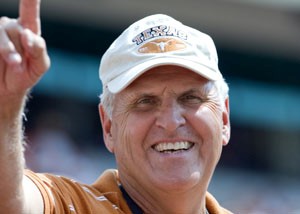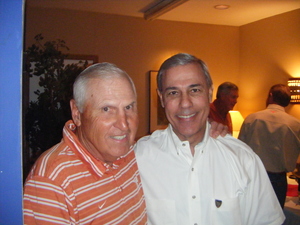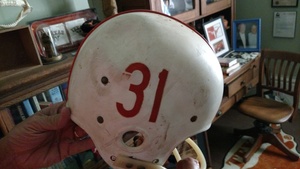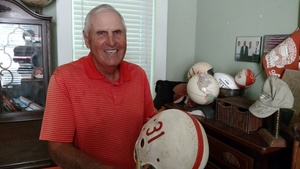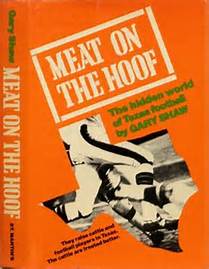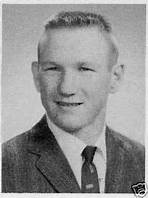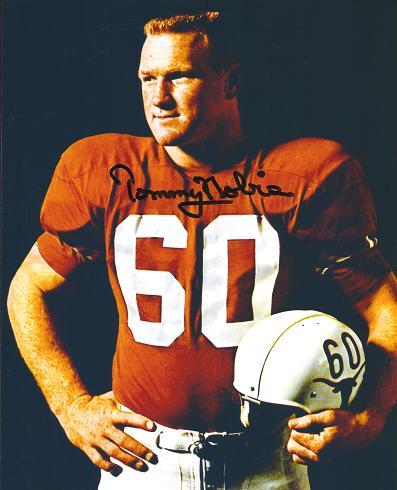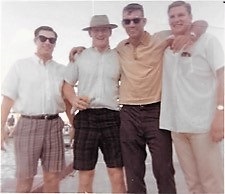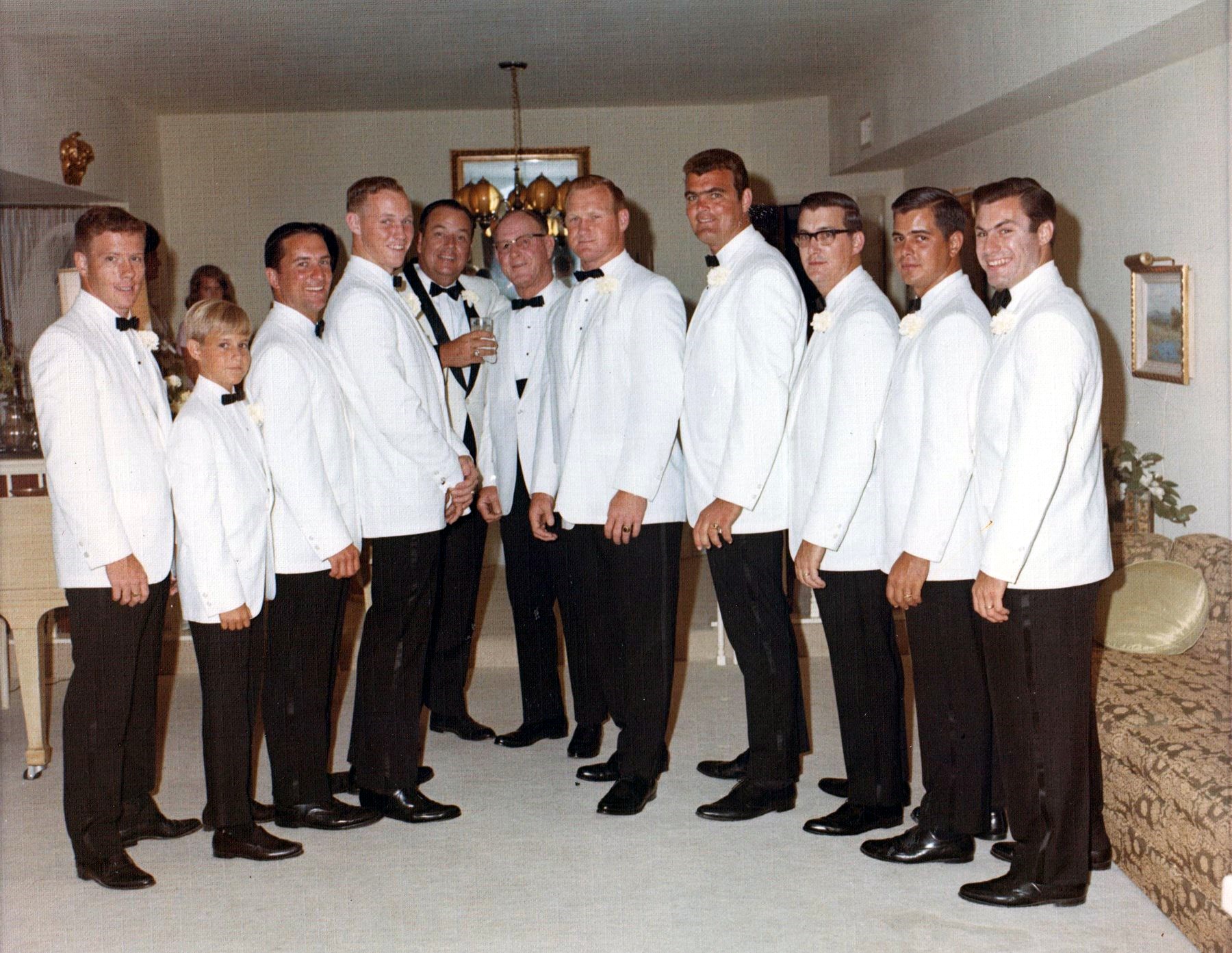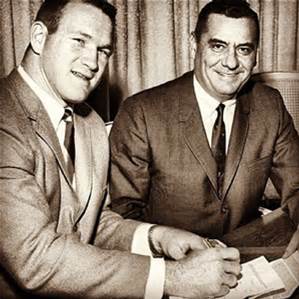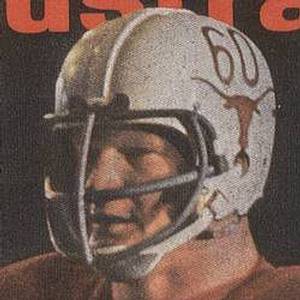PAT CULPEPPER EDITED BY BILLY DALE for the TLSN site
Pat Culpepper’s accomplishments are a reminder to all Longhorns that In sports and far beyond, his contributions to Longhorn heritage shape the present and empower the future.
DKR said Pat was “the bubbling extrovert, ready to play at the blow on a whistle.”
Most Of The Comments Below Are From Pat Culpepper's Articles In Inside Texas. I Have Added Photos To His Comments So The Readers Can Associate Pat's Story And The Subject Matter.
During Pat’s playing years at Texas, he was known as Mr. Wildcard.
The rules committee allowed one substitution to rotate in every game. Pat was chosen for this role, and Pat made the most of his linebacker hunting license.
“Inside Texas” states that
"Pat Culpepper played for The University of Texas from 1960-62 and graduated from UT with a B.A. degree with honors in history. He coached college football for 12 years as an assistant at Texas, Colorado, Tulane, Baylor, and Memphis State and was head coach at Northern Illinois from 1976-79. He also spent 16 years as a high school coach in Texas at Midland, Lufkin, Galveston Ball, Westfield and his hometown of Cleburne. He was selected to the Longhorn Hall of Honor in 1991. His commentary appears regularly in the Inside Texas magazine and at InsideTexas.com."
A link to his site is below.
Http://Insidetexas.Com/Author/Pat-Culpepper/
Pat Culpepper is a linebacker for Texas from 1960-62 and led the team to two SWC championships in 1961 and 1962.
He is best remembered for his hit [along with Johnny Treadwell] on Arkansas' Danny Brabham in 1962 that forced a fumble at the goal line and spurred the Longhorns to a 7-3 victory and a SWC title.
Pat is best remembered for his hit [along with Johnny Treadwell] on Arkansas' Danny Brabham in 1962 that forced a fumble at the goal line and spurred the Longhorns to a 7-3 victory and a SWC title.
BELOW IS AN ARTICLE ABOUT PAT CULPEPPER'S INDUCTION INTO HIGH SCHOOL HALL FAME
MAY 26, 2011
How excited are you to be inducted into the Texas High School Football Hall of Fame? Well just look around me, all of these displays of great players. Of course whoever picks back in the fifties has to have a great memory, because there aren't any fans or anything else, so it's more a word of mouth deal. We were fortunate in Cleburne [Texas] because we played against great teams like Temple, Garland, Sweetwater, and so many [other] great teams we played against. We were lucky to win some of those, and it brought attention to our little town. So I get rewarded for this, along with David McWilliams who came before me, but we played high school football together and college football together at Texas. It's good for Cleburne right now, because we are struggling a bit right now in football. So all of the folks in town got excited about it, so it made me feel good that I could help in that capacity, to bring a little light on football back in our town.
Did you ever think you would receive an honor such as this? Not really, because when you are growing up you see so many great players like Bobby Boyd, Larry Hickman, Jerry Tubbs - who played for the Cowboys later, and who of course was an All-American at Oklahoma. You see those kinds of players, and when you are growing up you don't picture yourself in a group like that. So being here is certainly an honor for me.
Pat Culpepper
Why did you choose to play football at the University of Texas?
They took about 55 players in those days, and I was one of those 55. Coach [Darrell] Royal was looking for guys that wanted to play against Oklahoma, and that's the kind of challenge he put out. I had seen the Oklahoma-Texas game when the last Texas [team] had beaten them, and Eddie Crowder was the quarterback at Oklahoma with Billie Vessels, and Texas won 9-7. I thought that was a great arena, and I thought going to Texas I would get to play in that game. So it was great to play for Darrell Royal and to play with all of the great players like Scott Appleton, and Don Talbert, that were All-Americans, and James Saxton. All of those guys were great players that I played on defense for. So that was a great thrill for me. And because I played at Cleburne, and we won, I got a chance to go to Texas.
How did Coach Royal influence your career after playing for him at UT?
He got me a lot of jobs. I would call and say, "Coach, I am interested in this kind of job." And he would call [someone for me]. Coach would call, and he gave me my first coaching job, and he also got me on at Colorado with Eddie Crowder. Coach Royal and Crowder were close because of the Oklahoma connection, so he helped me there. And then when I was head coach at Northern Illinois, he came up and spoke at a clinic, and we had two thousand area Chicago coaches come in to that school for the first time and see our facilities and listen to coach Royal. So he's always been like that for me, wherever I have been.
What was it like to coach on a national championship team?
Well, I was a coach of the national championship team in '63. That was my first year coaching. And then my second year we had an assistant coach that hurt his back skiing, and we needed to recruit, and [Royal] said that if you're interested in going into coaching, I have got a spot. I was going to be commissioned in the Marine Corps, and I told him and said that I had to turn in my commission, I've got to go into the reserves, and he said whatever it takes, you come on with us. I came in and recruited in the San Antonio area. And then in `64 we played Alabama in the Orange Bowl and beat them. Coach [Paul "Bear"] Bryant never beat Coach Royal. So that was a great thrill to watch that staff work because I had played for them, and when you watch a group of people work that are successful, it's good for you as a young coach.
What was it like winning Texas' first national Championship in 1963?
That group, we had played together for two years. It was Duke Carlisle, Tommy Ford, and that whole group. So they got to a point that before they played the Navy team in the Cotton Bowl, a lot of people were talking bad about them nationally like they hadn't played anybody, or they were lucky to beat Oklahoma. And they built up Navy so much that those boys at Texas that I was coaching, you didn't have to say much to them. They were ready to stop Roger Staubach. We had worked hard on containment, and when he would start one way and roll back, there was a defensive end in his face. It absolutely stopped their attack. Also, Navy had played goal line defense in the middle of the field, and we hit them with two touchdown passes in the beginning of that game. It was fun to be on the sideline watching that, and the first time Roger Staubach rolled out, Tommy Nobis hit him right in the chest in front of our bench, and I'll tell you what, we could have played the Russian Red Army after that one because it made our whole bench come alive.
Tell us about your big hit on Danny Brabham against Arkansas.
Pat Culpepper’s mother shows off his memorabilia .
Arkansas was averaging 42 points a game, and that was in 1962 which is almost unbelievable. They came into Austin, and it was a hot night - it was 89 degrees. They had us down 3-0 and they got the ball down on our two yard line, and that's when Johnny Treadwell said we have got them where we want them. They had thrown the ball to get down there, and they ran their fullback, and our defensive line got under [current Dallas Cowboys owner] Jerry Jones and their group up front, and we hit Danny Brabham at the same time and the ball rolled right over our shoulders. And that young man, Danny Brabham, got death threats for the next two weeks. That affected him the rest of his life. That's how big [the game was], and it wasn't on television. It was on radio and the 64,000 people that were there and that was it. But that picture was captured by Al Panzera of the Fort Worth Press, who got down in the end zone expecting a touchdown and caught that picture. I sign - usually once a month - photographs of that reproduction.
Culpepper's boots
Why is that game so special to people in Texas? Maybe they remember it more because they heard it on the radio. It's incredible how many people remember that game. It was a great game, because we were No. 1, and we had been No.1 since the season started. And Arkansas came in at No. 7, but two teams had lost that afternoon. It was a night game and they had moved up in the rankings, and it was quite the football game. We scored with thirty-six seconds [remaining] to win, and we go to the dressing room, and Coach Royal said the people aren't leaving unless we go back out on the field. We got back on the field, and then we went back to the dressing room, and Lyndon Johnson - Vice President Johnson - was on the phone calling Coach Royal. It was quite a momentous occasion, and I don't think anybody went to sleep that night. The horns were honking on campus. You couldn't go to sleep. Everybody was up yelling and going on in the streets. It was just that kind of game because we won on a 20-play, 85-yard drive, with three fourth-down conversions. So it was just one of those deals.
What does the game of football mean to you?
It's the epitome of competition. I wasn't a big guy, and I had to make up a lot of ground. In my coaching career I tried to put that in players - that size doesn't matter, it's what's in your heart. If you really want to win, and if you really want to work, you have got a chance. I think that generation that I came through, epitomized that. So the coaching part was fun and the playing was tough, but it had its rewards along the way. Now, I was lucky to play with some real good football players as well, so that helped a lot. Playing for Darrell Royal was unique. That was a great staff, and the Southwest Conference was extremely strong at that time. Rice was a great team under Jess Neely. Baylor was [an] excellent football [team]. SMU had a very good football program. Of course, Arkansas and Texas were back and forth, and you had a great conference. Texas Tech was just coming in, and Texas A&M was always tough, but they changed coaches too many times after Coach Bryant left.
To see more of his articles onInsidetexas click on the link below
http://insidetexas.com/author/pat-culpepper/
Article about the impact the book MEAT ON THE HOOF had on Coach Royal- written by Pat Culpepper.
The Comments Below Are From Pat Culpepper's Articles In Inside Texas. I Have Added Photos To His Comments So The Readers Can Associate Pat's Story And The Subject Matter.
The phone rang, and he spoke briefly with Pat Culpepper, his onetime linebacker, team captain, and staff assistant, now a high school coach in Midland. Culpepper was from Cleburne, which contributed a disproportionate number of top players during Royal’s early years – Timmy Doerr, David McWilliams, Howard Goad, and Fred Sarchet. They were the kind of players Darrell favored: small-town kids who believed in the program and toed the coaches’ line. As a UT assistant, Culpepper also played a prominent role in Gary Shaw’s Meat on the Hoof, the 1972 book that kicked the first large dent in Darrell’s expertly chiseled public image.
Shaw, a reserve guard in the mid-sixties, portrayed Culpepper as a screaming fanatic in charge of the brutal “shit drills” designed to discipline uncooperative players and chase off others whose scholarships were needed for the next class of recruits. Culpepper has since compiled his own version of the Royal years, and that was the purpose of his call. Darrell told him he’d be glad to read the manuscript.
Shaw portrayed “Daddy D” as a man who could stand over a talent like George Sauer when he was writhing on the ground with a knee injury and, completely detached, finish eating a hamburger. And Sauer was a gate attraction and the son of an old friend. “Coach Royal met my parents once when I was being recruited as a freshman,” Shaw wrote. “Four years later he ran into them after a football game and immediately called them by their first names. Three years after I was gone and a full seven years after meeting them, Royal met them again at the Denton Country Club. Again, without hesitation, he addressed them by their first names. Maybe, you say, he just has a memory for names and faces. Yet two years after I’d played for him for your years I ran into him on campus and he couldn’t recall mine. A player that has come and gone and has no PR value is a different case.” Meat on the Hoof drew blood, and the coach didn’t respond kindly. “Shaw says he took psychiatric treatment when he was here,” Royal said at the time. “That’s kind of common these days – but I have never felt the need to go take treatment.” He has since mellowed on the subject. And give him credit: he at least read the book. Tom Landry is never going to turn a page of North Dallas Forty.
“I don’t deny at all that we ran a tough program, especially back then,” said Darrell.
A link to a article about Gary Shaw is below.
http://www.austinchronicle.com/news/1999-07-09/522343/
CULPEPPER’S COMMENTARY on James Street
September 30, 2013 by Pat Culpepper
James Street had a heart attack, and that’s the only thing that ever beat him. His enthusiasm, his smile, and his love for his sons overcame all obstacles. His teammates loved his spirit and gathered around him like the huddles he commanded during the 1968-69 seasons.
When we had lunch with coach (Darrell) Royal, James would always sit next to the coach and get him to smile. He was like Royal – not tall, not blessed with all the talent – but overcame anything. Royal had to be the dustbowl and lack of love from anyone except grandma Harmon in Hollis, OK. Street’s home was in Longview, TX, and his father thought he should make it in baseball. If Emory Bellard had not been invited on Royal’s staff and come up with the Wishbone, Street might not have ever gotten under center. Gone are the days of the huddle for many teams, and Street was the master of leadership skills. He had energy, guts, and was a fighter. The play calls for the Wishbone were simple. “Liz (rip) 22 dive, on two.” Not near the complexity of today’s sideline, signal-waving coaches, shouting directions to the QB in the shotgun. This allowed Street to call out his teammates. “McCoy (Bob), get your block,” was the kind of stuff Street would instruct. We will all miss him and can’t forget his plays in Fayetteville in the “big shootout” that gave the Longhorns a chance at the National Championship. Everybody who loved football watched as Street brought the ‘Horns back against all odds with his passing, running, and leadership. His name is on the DKR-Memorial Stadium, as it should be, next to Bobby Layne, Vince Young, and Colt McCoy. I will miss him. Thanks, James. For what you gave all of us who played at Texas.
A link to an article about Coach Royal is below
http://insidetexas.com/news/story.php?article=2205
Pat Culpepper's article on a Orange Blood blog about Tommy Nobis
Can I tell you about the greatest college football player I ever knew? Yes, he later
went to the NFL and played for the Atlanta Falcons, where he made All-Pro
numerous times. In his senior year of college football, he won the
Outland Trophy as the best lineman in the game. He played both ways as
an offensive guard and as a middle linebacker. He came from San Antonio's
Thomas Jefferson High School, and I saw him initially in August of
1961. I was a junior linebacker on the Texas Longhorn football team, and
we had a scrimmage in Memorial Stadium; it was the last scrimmage
before we were to start the season. That hot morning our defense was on
fire, and we had stopped the offense on four straight downs with the
ball inside the five-yard line.
All of us on defense were happy about what had happened that morning.
Our defensive lineman had submarined under the offensive line's charge
and left Johnny Treadwell, who was the other Longhorn linebacker, free to
attack the ball carrier. I loved those glancing hits on the runner
like I now love solid golf-shot contact. So our side of the dressing
room was in a good mood. We had come through two weeks of full pad
practices in the Austin heat and humidity. There were water breaks for
the first time because of heat problems around the Southwest
Conference. In fact, we had five players taken to Breckenridge Hospital
with heat dehydration. Only one never made it back - Reggie Grob from
Houston. He died along with the senior captain from SMU, Mike Kelsey.
Doctors thought the new plastic shoulder pads had something to do with
the heat problems. Most of us wore expensive leather shoulder pads that
actually got wet with our sweat which let some air through the jerseys,
while the plastic pads encased the player and did not allow any air.
Before those youngsters died, we never got water breaks, but our head coach Darrell Royal, like other coaches, learned a tragic lesson. We went to Reggie's memorial service in Houston as a team in two buses on Monday of our first game
week.
It was Coach Mike Campbell, our defensive coordinator, who came by my locker and asks me to go check out Jefferson's middle linebacker who would be scrimmaging against Austin High at House Park that night. That afternoon we watched the scrimmage films critiqued by the Texas defensive staff of Campbell, Charlie Shira and T. Jones. It was more than a highlight it clearly showed we were ready for the season. Later that afternoon I went with my roommate Budda Phillips, a big red headed tackle from Franklin Texas along with our dates to set some great Mexican food at El Toro restaurant. I excused myself and Bubba took his date and mine to the movie in downtown Austin while I left for the scrimmage. It was already getting dark and I could feel the preseason excitement of football streaming from the lights to the green playing
field. San Antonio was on defense and Tommy Nobis was not hard to spot. I walked behind the end zone and while Austin was huddling, the thin, bow-legged Nobis was getting the defense set. He moved from
side-to-side, shaking his shoulders. You could tell he was talking to his down lineman, constantly pushing back his shoulder pads, getting ready. I was in the perfect spot as the Austin Maroons ran a lead play to Nobis' left. The Jefferson defensive line had a good charge-like our lineman that morning-and I could see a hole open. Nobis filled it
like a rocket. The lead blocker was knocked straight back into the ball carrier and Nobis stuffed them both. The Jefferson coaches went crazy! The next play was a sweep and Nobis knifed into the runner, bouncing him out of bounds for no gain. Austin High did not score in that series.
I had seen enough, and I left to join Bubba and my date at the downtown picture show as I remember a John Wayne western. To say the least, my report to Coach Campbell, who recruited the San Antonio area, was more than positive. From what I saw he could cover ground quickly, and when he arrived he was in a bad mood! You could hear his tackles. He would only get better and bigger at Texas. My guess in high school, he was 6'3", 190 lbs., and by his senior year for the Longhorns, he would be 220
lbs. with a 21" neck.
He loved the University of Texas-still does. The freshman played on the
freshman teams in the 1960s, and after the 1962 Shorthorns, as they were
called, lost to the Baylor freshman, Nobis came to my room and knocked
on the door to apologize. It was as if he had let me down since I was one
of the starting linebackers and co-captain. As I was to learn, he was extremely hard on himself in his evaluations. We made him stand up and
sing his school song at supper meals at our training table at Moore Hill
Hall. His voice was always off-key, and some of the other seniors would
cut his alma mater of Thomas Jefferson High School off after the first
few notes and send him to the freshman eating area. There was always a
smile on his face, red hair on top, and freckles.
He was given nothing to come to Texas except his scholarship, and he
struggled with his grades like many other freshmen. To his credit, he
graduated from the university. In 1963, his sophomore season, Nobis
broke into the starting unit. It was to be the first National
Championship team for the Longhorns. They had held the No.1 ranking
during the seasons of 1941, 1961, and 1962 but had never finished as the
top college team. As the season went along, Nobis began to make his
mark at both offensive guard and linebacker. I was one of the freshmen
coaches but assisted Coach Campbell in grading the varsity
defensive films on Sunday. What Nobis did against Austin High in that
pre-season scrimmage in 1961 he began to do at Texas. In addition, he
was a tremendous blocker at the offensive guard.
The Greatest
By the time we got to the Cotton Bowl in Dallas to face Navy for the
National Championship Nobis was a force to be reckoned with. Let's put
it this way, it is easy to understand how smaller players get wound up
to play football. They must if they are to compete against bigger,
stronger, and possibly faster opponents, but…and this is big; what about
an athlete that has the perfect build for his position, along with the
speed and ability get as serious about playing all out hard every
play? Then you have an exception, and that would be Tommy Nobis of
Texas, a one of a kind. On Navy's first offensive series, QB Roger
Staubach scrambled toward the Texas bench repeating a maneuver that he
had used all season to set up passing plays downfield and right in
front of Coach Royal, myself, and all of our sideline players, "Roger
Dodger", as he would later be called when he played for the Dallas
Cowboys got lit up by the Texas sophomore linebacker from San Antonio.
Nobis hit Staubach straight up, and the collision ignited Texas
bench, the Texas fans, and as a matter of fact, the Texas Band.
Jersey retired
In 1964 the Longhorns only lost one game, a 14-13 cliffhanger in
Austin to Arkansas. So Texas was picked to play Alabama in the Orange
Bowl in Miami. It was Nobis who stopped 'Bama QB Joe Namath on a 4th
and inches QB sneak to preserve a 21-17 Texas win. I was on the Texas
coaching staff then on a permanent basis. That spring coming
into Nobis' senior year, professional scouts came to our practices to
compare Nobis to Illinois' senior linebacker Dick Butkus. The main
difference was that Nobis could move faster than Butkus; both were
devastating hitters.
So two weeks ago last Saturday night, members of the 1963 National
Championship were honored by the University of Texas on Friday at an
elaborate supper for players and wives before the Longhorn’s opening game
against New Mexico State. Sadly, there were only two coaches still
alive, and at least nine of those members of the team had passed away.
Nobis and I reunited. His red hair is long gone, and my brown hair has
left as well, but there is still that understanding, that bond. Tommy
will receive some money from the NFL now since the settlement of the
760+ million dollar lawsuit was recently settled. He suffers from a
slight, very slight, case of dementia and, in his own words, "There are
lots of guys worse off than me." In 1964 when writers asked Darrell
Royal, when he would begin to implement the change in rules so he could
platoon his players offensively and defensively, his reply was short,
"when Tommy Nobis graduates."
The writer was also an awesome LB at Texas- Pat Culpepper
Hook'em





